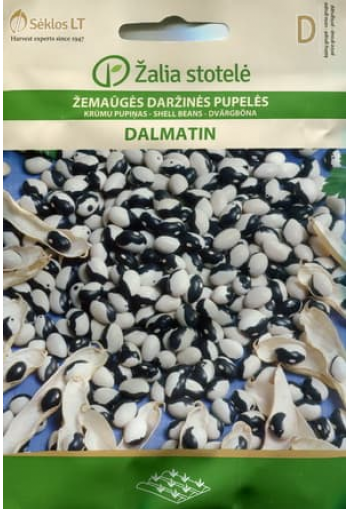Ex Tax: 1.14€
An early to mid-early variety intended for harvesting dry seed. The pod is of average length, light green in colour, stringless, oval in section and weakly curved.
The seed is large, oval, black and white, with approximately half of the area around the hilum being black.
1,0 g = 2-4 seeds.
* During the harvest of beans, peas and beans, it is necessary to collect the pods in the morning, so that until the evening, when the humidity increases, the "wounds" on the plants have time to dry out and do not become a place of penetration of pathogens of fungal diseases.
Curly beans are sown only in beds located from north to south, at the northern edge of the site, near fences or separately growing plants.
When inter-row planting, a row of curly beans should occupy a strip 1 m wide, and the distance in the row between plants should be 30-40 cm. As soon as the height of bush bean plants reaches 15 cm, they should be lightly hilled. Shortly before the formation of tops, bush beans are spudded again, but more strongly. This technique helps to increase the endurance of plants.
When harvesting, bush bean plants should not be uprooted but should be cut at the root. Thus, roots with nodule bacteria remain in the ground. Being in the soil, they enrich it with humus and nitrogen. Therefore, after beans, vegetables grow well in this place without additional nitrogen fertilizer, since the soil on which the beans grew is already rich in nitrogen.
The stalk of curly beans must be pinched at a height of 2-2.5 m, otherwise, the beans will grow until late autumn and will not have time to ripen. Pods are removed selectively when they turn yellow. After drying, they are threshed.
In early August, it is recommended to pinch all flower brushes with buds and the tops of the beans so that the pods have time to ripen.
It is important to properly store the harvested beans: small - in bunches, and large - in pods. This will protect the bean grain from the bean weevil, which starts up when stored improperly.
It is better to keep stocks of beans peeled from pods in a bag on the street, balcony, veranda or in the corridor (in the cold). If the bean weevil is still wound up, then the collected grain is poured into a bucket with a solution of sodium chloride (300 g of salt per 1 liter of water). Seeds infected with caryopsis float, they are collected, scalded with boiling water so that the beetles do not spread, and such grain can, for example, be fed to poultry. Healthy seeds are washed and dried.
Did you know that... young bean pods can also be salted: place 1 kg of chopped pods in layers in a container, sprinkling them with salt (300 g).











